Dracula, Frankenstein (1931)
Directed by: James Whale, Tod Browning
Written by: Bram Stoker, Mary Shelley
Starring: Bela Lugosi, Boris Karloff, Colin Clive, David Manners, Helen Chandler, Mae Clarke
Renfield, an English solicitor, travels to Castle Dracula to discuss Count Dracula’s buying of a place called Carfax Abbey in London. When the driver of his stagecoach refuses to go any further, another coach, driven by Dracula himself unbeknownst to Renfield, appears and takes him to his destination. At the castle, Renfield faints and is almost attacked by Dracula’s three wives until the Count waves them away and bites him himself. Renfield, now a raving lunatic, brings Dracula to England via a schooner, which arrives in the country with all the crew dead except Renfield, who is taken to an asylum. Dracula bites a girl selling flowers, then appears at the theatre and introduces himself to Dr Seward, his daughter Mina, her fiancé Jonathan Harker and their friend Lucy Westenra. Lucy is fascinated with the Count and that night, he comes to her….

Watching Dracula is a rather strange experience. It’s stagey to the point that you feel you are virtually watching a play, is lacking in much excitement or even suspense, and frustratingly seems to relocate most of Bram Stoker’s great novel to drawing rooms. It’s still a film that has been much loved through the decades though, and this must be in part to not only Bela Lugosi’s iconic performance but also to its incredible atmosphere. The film has a sleepwalking feel, its turgid rhythm actually very compulsive if you’re in the right mood [I tend to watch these movies around midnight, by far the best time!], and refuses to be actually boring, though perhaps it should be. If you’re not used to the really old horror classics though, this probably isn’t the best one to start with, even though it was the first of the Universal horror series, I would almost recommend watching Frankenstein first, as it’s far more fluid.
This wasn’t quite the first Dracula movie – in 1922 there had been the German Nosferatu, which had been an unofficial adaptation and had many prints destroyed. The idea of an American version of Stoker’s book at Universal first arose in 1929, when producer Carl Laemmle wanted a big budget movie starring horror star Lon Chaney, in the manner of The Hunchback Of Notre Dame and The Phantom Of The Opera. Chaney’s death and the Depression meant that this version never went ahead, and the film that was eventually made was adapted word for word from a very popular stage version starring Bela Lugosi, who still had to lobby hard to get the role in the film. This play was actually fairly close to the book, though of course some of Stoker’s more fantastical scenes had to go and oddly the character who arrives at Castle Dracula was not Jonathan Harker, but Renfield, the person who becomes Dracula’s slave. Director Tod Browning apparently was not comfortable making a ‘sound’ film and cinematographer Karl Freund shot many scenes. A Spanish version of the movie with a different cast was shot on the same sets at night time, a practice which seems odd but was done fairly often at the time. This version is longer and talkier, because it filmed the entire script unlike the American version which removed a few pages, but is slightly more upfront in its horror. When released, Dracula was a huge success, with many people reported fainting, though when re-issued in 1934, the recently formed Production Code ensured the toning down of a couple of sound effects and an epilogue, now sadly lost, where Prof. Van Helsing, Dracula’s nemesis, says to the audience “there are such things as vampires”.
The first twenty minutes of Dracula are usually described as the best, and that is certainly true. There’s a somewhat fairytale feel to the remote village that Renfield arrives at, replete with painted in Carpathian Mountains in the background – the effect, though hardly realistic, creates a slightly surreal atmosphere. When someone mentions Dracula, we are shown Dracula and his three wives waking up and gliding about, with one great shot of a rat climbing into a tomb out of which a skeleton’s hand protrudes. Unfortunately, this scene also begins something which most Dracula and vampire films carried on doing – the avoidance of showing the creatures getting out of their coffins. I know it must look clumsy, but the constant cutaways and then cuts back to Dracula standing up quickly became laughable in movies. Anyway, when Renfield arrives at the castle, the sense of doom is incredible as he goes inside and is dwarfed by the huge main room. Many Dracula films succeed in creating a fine castle, but the one here is by far the best. Unusually, it’s almost ruins, as if it hasn’t been lived in for centuries, and I wonder why more versions haven’t employed that idea. It seems more realistic in a strange way – Dracula spends the days sleeping and the nights finding victims, so when would he find the time to maintain his decrepit abode? Rats and [oddly] armadillos scurry about and a gigantic spider’s web hovers half way up the steps, truly making Renfield like a fly as he slowly climbs them. A bit of business from Nosferatu is repeated with Renfield cutting his finger and Dracula stopped from sucking the blood by a crucifix, then we have a longer scene with the brides, who seem to come from a very bright room, but does this really matter, considering it’s hardly reality that is being portrayed here? The sequence of the brides attacking Renfield and being banished by Dracula is usually quite a horrific sequence in versions, and here it’s extremely tame, without even any physical violence – the brides don’t even get to touch Renfield, but it still works rather well.
There’s no doubt that after this the film goes down a few notches, with characters constantly meeting in rooms and talking, and little mounting tension despite the exciting story. Stoker’s tale is basically there, despite many of the good bits, such as the sighting of a white dog, happening off screen, and I reckon several scenes were intended to be shot but just weren’t for fear of censorship – I doubt the play was as short in length as seventy minutes! Surprisingly though, there is mention of the vampiric Mina attacking children, one of the nastiest elements of the book. Nice use is made of silence in some scenes, such as when Mina rushes into her garden at night in her white gown to be embraced by Dracula who is waiting in the shadows and seems to wrap his cape around her. As a young child I was a bit creeped out by the scene where Lucy is becoming like a vampire and is obviously building up to attacking Harker. The scenes in Carfax Abbey, another wonderful set, have much of the feel of the scenes in Castle Dracula though the climax, which tales place at Carfax Abbey rather than Castle Dracula [again, just like the play], is weak, with Dracula being staked off screen. I know they wanted to avoid showing blood and gore, but surely they could have shown Dracula at the moment of death?
I must also say that the sexual element of the story, which was certainly there in the novel and was later exploited in later versions, is only very vaguely hinted at in this movie, and to be honest if you’re not aware of it already you may not notice it at all. Of course we don’t properly see Dracula biting people, with the camera always cutting to the next scene. Bela Lugosi became a sex symbol after this film, and, although it’s perhaps easy to laugh a little now, one must judge his performance by the standards of the time, though it’s not helped when the torches being shone into his eyes to show his hypnotic power often miss! I actually love the way he moves like a walking corpse, the way he adds pathos in his rich Hungarian accent to certain lines [such as “to be dead.. that would be truly wonderful”] and the way his face in one notable scene seems to contort into intense agony as he gets really close to the camera to bite someone. He remains an oddly sympathetic Dracula, you almost getting the feeling he really doesn’t enjoy being a vampire at all. It’s said he didn’t know any English and learnt his lines phonetically, but that has been disproved by some sources. As to whether he’s my favourite, it’s hard to say. Christopher Lee played the Count in more films than anybody else [in fact Lugosi only played him in one other film, Abbot And Costello Meet Frankenstein, though he played Dracula-like characters a few times], so I tend to go for him more, but there have been so many great performances in the role, from Klaus Kinski to Gary Oldman, it’s really hard to say.
Apart from Lugosi, the only other really interesting performance is by Dwight Frye as Renfield. He’s another character most actors relish playing, but Frye is one of the best, wonderfully wide-eyed and frantic, but again, you feel a little bit sorry for him. The rest of the cast slowly pace around, then gesticulate as if they were in a silent movie, and considering that many of these players gave far better performances in other movies [such as the following year’s The Mummy], some of the fault must lie with Browning, who just doesn’t seem entirely focused on the film and almost botches a couple of moments which would normally have great impact. Except for an excerpt of Tchaikovsky’s ‘Swan Lake’ during the opening titles and a few notes at the end, there is no musical score, as was the norm for early sound features, and this oddly helps the film – it seems to add to the atmosphere. There’s a version with added Philip Glass music [it’s on the current DVD], and, though I like his music a lot, I didn’t feel it added to the film, – in fact it irritated me and I turned it off ten minutes into it! There’s a great deal at fault with Dracula, and I would say that there are at least three versions of the story that are better, but it has some great things in it and remains one of those films that is greater than the sum of its parts. Its importance in the history of the horror movie cannot be denied and its success led Universal to embark on a series of wonderful chillers, some of which are amongst the best films of the genre ever made.
Rating: 









In a graveyard, two men, Dr. Henry Frankenstein, who is intent on building a man and giving him life, and his hunchback assistant Fritz, dig up the body of a man. When they realise the head and the brains of the body are severely damaged, they decide to steal a brain from Frankenstein’s former teacher Dr. Waldman. Fritz accidentally drops on the floor the glass jar with the label “good brain” on it, so he decides to take the glass jar with the label “bad brain”. Despite protestations from his fiancée Elizabeth, Frankenstein spends every waking moment in his tower on his ‘work’, and eventually, using a ray he has discovered, brings his ‘man’ to life….

Frankenstein is the first true masterpiece of Universal’s horror cycle. If Dracula was a somewhat awkward start with flashes of brilliance in it, Frankenstein is a brilliant piece of work through and through, as if the film-makers [much of the Dracula crew went on to this one] had now found their footing and were out to show how good they really were. This is a fantastic, extremely poetic dark fairytale filled with scenes and images that not only will never be forgotten by viewers but have influenced countless films and indeed popular culture since, and whilst many film fans have their own idea of what the greatest version of Dracula is, I would say more than half would probably say that this movie is the best film of Mary Shelley’s famous novel. I wouldn’t say that it’s actually the best film about Frankenstein, but that is to come!
After the huge success of Dracula, Universal looked around for another well known horror property and chose Frankenstein. Robert Florey was set to write and direct, and again the inspiration was a stage version which scaled down the novel, though Florey had the Monster as a pure evil creature. Bela Lugosi, now a big star because of Dracula, was immediately offered the role of the Monster, and Florey shot 20 minutes of him on the Dracula sets. Sadly, this footage is now lost. Now sources differ as to why Lugosi then walked – some say that the makeup didn’t work, some say that he didn’t like the fact that the Monster was unsympathetic, and some say that he wanted the Monster to talk, which would hardly have worked with Lugosi’s thick Hungarian accent! Anyway, he left, and soon after Florey, who wasted time not really knowing what to do with the project without Lugosi, was replaced by James Whale. He’d just had a success with Waterloo Bridge and two other war orientated films, so wanted a change. John Carradine also turned down the role of the Monster and Boris Karloff, who was an extra at the time, only got the gig because make-up artist Jack Pierce noticed him in the staff canteen and imagined he would look great with the make-up on. John L.Balderston re-wrote some of the script, under Whale’s encouragement, to make the Monster more likeable. The film was partially shot on sets left over from the 1922 version of The Cat And The Canary. The studio insisted Whale shoot a light hearted coda with Frankenstein recovering off screen. Still, it was another great success at the box office, but when released again in 1934, it received more severe cuts than Dracula did. Removed were bits of Fritz torturing the Monster, his hanging body, Frankenstein’s line “now I know what it feels like to be God”, and the Monster accidently drowning a young girl, actually ruining the latter scene, but more on that later.
Frankenstein opens with the titles against two cards, one with lots of eyes which is rather uncanny, and one a picture of a giant looming over people and buildings. I’ve always wondered what that picture actually is, and after investigation I discovered that it’s actually a very early poster for Frankenstein when Lugosi was supposed to play the Monster, the giant being Lugosi! The film then launches straight away into its story seemingly already partially through it, with Frankenstein and Fritz digging up a dead body in a graveyard. We don’t find out exactly why they are doing this for a short while. The movie then races through its plot at great speed, only occasionally pausing for some comic relief from blustering old Baron Frankenstein, who thinks his son is shut away in his tower because he’s got another woman besides Elizabeth. This is a quite magnificent set which is influenced by German Expressionism, all twisted and distorted – for example the stairs and beams are not quite where they should be and are shot at strange angles to accentuate this. This psychological approach to set design creates an incredible mood of horror and madness without hammering it home, the architecture mirroring the minds of more of one of the protagonists. The film doesn’t waste time over-emphasising this though and soon gets on the with the business of bringing its monster to life, amidst Kenneth Strickfaden’s terrific, Metropolis-inspired scientific equipment, whose straight, somewhat logical design contrasts in an almost surreal way with the madness of the building it’s in.

Now there’s no doubt that having the covered-up Monster’s hand move to show his coming to life has become a cliché now and has therefore lost some of its effect, but just imagine how much it must have scared audiences of the time. The Monster’s appearance is withheld just a bit longer as we don’t him coming to life ‘properly’ but go forward a few days. He has obviously been living in a room for a bit and we hear him coming up the stairs, then he enters the doorway backwards, as if he doesn’t know which way to walk. Slowly he turns round, and to increase the horror, cinematographer Arthur Edison gives us three rapid shots of the Monster’s face, each one closer. If audiences screamed loudly in 1925 when The Phantom Of The Opera had that mask torn off by Christine, they probably wet themselves with the first sight of the Frankenstein Monster. Jack Pierce would make adjustments to the makeup with each successive film, often to suit each particular actor, but the Frankenstein make-up is the most horrifying. After the Monster has left the castle, we come to the famous scene of the Monster encountering a little girl, an extraordinarily poetic scene which is at first really beautiful, an idyllic momentary respite from all the doom and gloom. The girl, Maria, invites the Monster to join her in throwing flowers in a lake, which he does, until he runs out of flowers, so he throws the girl in, thinking she will float. Instead she drowns, and the Monster looks really stunned and confused before going away. When this scene was censored in 1934, all you see is the Monster reaching for Maria, giving the impression of a far worse fate for her! The sequence of the villagers hunting the Monster brandishing torches and the climax in a burning building would also become cliches in the horror movie as a whole, not just in the Universal movies, but are still exciting and vivid here.
Now in the book the Monster is articulate, verbose and certainly doesn’t have a criminal brain, so it’s understandable that many fans of the novel consider this movie something of a travesty, but right from the offset this film is different to the book. This was partly out of necessity and the way things from the book are condensed is very clever – for example the Monster’s curiosity of and persecution by humanity are condensed into the scene with Maria – and if anything this Monster is more sympathetic. In the book the Monster is abandoned by Frankenstein and is left to wonder around the countryside. He is bullied and persecuted by humans, but his first actual murder is of an innocent. In this film, the Monster is rejected by his creator and is left to be pestered and tortured, by Fritz, virtually straight away, before he goes anywhere outside, and his first killing is in self defence. The whole thing about the Monster having a criminal brain has been said by some as perverting Shelley’s concept, but one can also say that if the Monster had received some understanding and compassion from his creator and humankind in general, rather than fear and hatred, then he may not have become dangerous. His development is shown in disturbingly relatable human terms. First of all he’s a baby, stretching his hands towards the sun streaming in, then he’s a child, playing games with Maria. He’s only a powerful, brutal adult in the final quarter. As for Frankenstein, although he’s supposedly the ‘hero’, he’s actually nastier than his book counterpart in that he not only rejects his creation but orders it to be killed. As with many films of the time, especially when the nominal ‘hero’ can maybe not be considered ‘normal’, it was thought necessary to add another love interest for the heroine, here a man called Victor. The character is played in a really stiff, inept way by John Bowles, and it’s a shame that the Monster doesn’t put this irritating man out of his misery.
James Whale’s direction uses some unusual angles and far more camera movement then was normal for the time. When movies first became sound, they were very static, largely because of the limited recording technology. Not so Frankenstein. Like Dracula though there is no music and in this case I think a score would have added to the film. Some of the acting is mediocre especially Mae Clarke as Elizabeth, and Colin Clive is perhaps a little hammy as Frankenstein, maybe coming across as overly earnest. You could say that about many performances around then though – whilst watching these films, one has to get used to the style of acting of the time. I actually love the almost insane relish with which Clive delivers some of his lines such as “it’s alive”! Of course Dwright Frye, fresh from playing in Dracula, has to play Fritz in the same crazy, wide-eyed fashion. In any case it’s Boris Karloff who is the star of the show, really giving an incredible performance of amazing subtlety. Many actors would have gone really over the top but Karloff doesn’t and remains surprisingly low-key, except for the moments when he attacks people and that skin crawling groan that he does. Beneath all that horrific make-up, his face has great sadness, making the tragedy of the Monster’s creation and rejection all that more moving. Because that’s what Frankenstein is. As much as it is a truly great horror film that hardly ever puts a foot wrong, it’s also a tragedy of mythic proportions, of innocence corrupted, and a savage indictment of humanity.
Rating: 










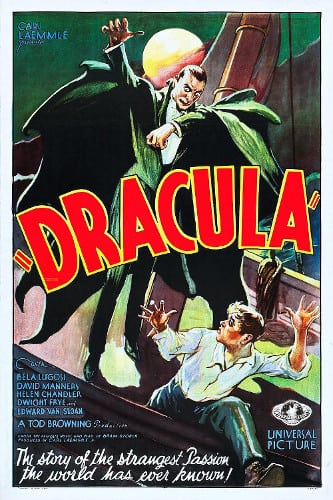
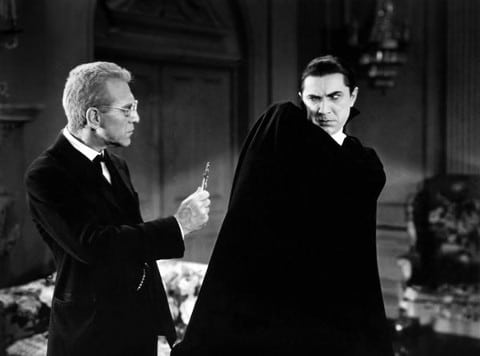


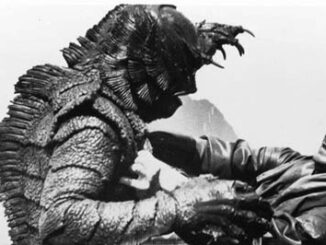
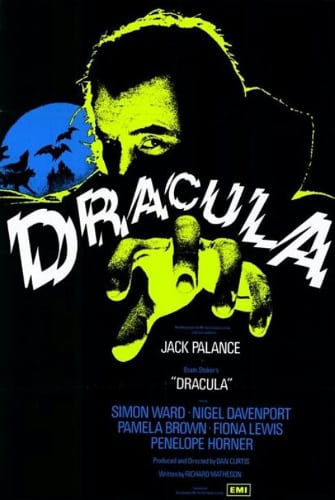
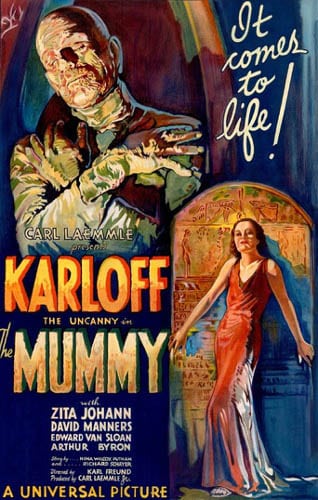
😆 😆 😆 😆 😆 😆 😆 😆 😆
THAT WAS AWESOME!!!!!!!!!!!!!!!!!!!!!!!
This really should be your thing on HCF…..seriously, the oldies bring the best out of you…….
A magnificent write up of two true classics,though i prefer Frankenstein more for it’s darker Gothic look and feel to Dracula.But there’s no getting away from it Bela Lugosi was Dracula and was never able to get away from that role to the day he died and got buried in his cape.